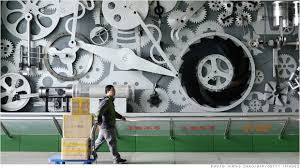Maybe Manufacturing Jobs Still Pay More
“When you’re trying to compare apples to apples,” Doms said, “you do see this manufacturing wage premium [has] been robust over time.”
Manufacturing has been a rare success industry in the recovery from the Great Recession, adding 500,000 jobs since the end of 2009. President Obama often hails it as a vehicle for middle-class prosperity.
From the mid-1970s to the eve of the recession, non-supervisory workers in manufacturing earned more per hour on average than the national average for all industries. During the recession and in the years that followed, however, hourly manufacturing pay fell behind the national average. In January, the average hourly wage for a manufacturing production worker was $19.23, compared with $19.97 for the private sector as a whole.
Commerce economists say the full picture is more complicated — and more favorable to manufacturing. They calculated in a report last year that medical and retirement benefits are 60 percent more lucrative per hour for factory workers than non-factory workers. When they compared workers with similar skills across industries, they found wages and benefits added up to a 17 percent advantage for manufacturing employees, an advantage that has held even as industry employment has shifted away from union jobs to lower-paying nonunion ones.
Doms says there are several explanations for that premium. Factory employees tend to work more hours per week and more weeks per year than other workers, he said, a difference that adds up — just like the compensation premium — to 17 percent.
If you include supervisors, who earn more than non-supervisory workers, factory employees earn more per hour than non-factory ones, he said.
Perhaps the simplest, time-tested explanation for why manufacturing jobs pay a premium is that the industry boasts consistently high productivity. There was new evidence of that in Labor Department statistics released Thursday. They showed manufacturing productivity increased by 2.2 percent last year, compared with 0.7 percent for the private sector as a whole.
Correspondingly, real hourly compensation for factory workers rose 0.2 percent for the year. Across the entire private sector, that compensation fell by 0.6 percent.




Leave a Reply
Want to join the discussion?Feel free to contribute!